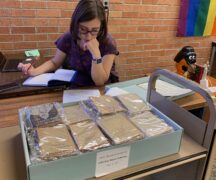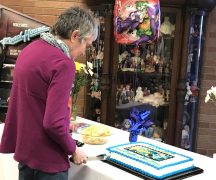By DAVID DUPONT
BG Independent News
For some university students, they have to make a choice — textbooks or food?
In its first meeting of the semester, the Bowling Green State Faculty Senate got a primer on how the university is trying to keep down the cost of those textbooks and other teaching materials.
Michelle Chronister, associate dean of University Libraries, said that some students face “the real choice” of whether to buy food or buy their textbooks. That makes keeping the cost of course material a critical issue.
Given BGSU no longer has a bookstore, those responsibilities have fallen to the University Libraries. “All aspects of textbook registration and textbook affordability have transitioned to the University Libraries,” Libraries Dean Sara Bushong told the senate.
BGSU is one of a few campuses that have done away with their bookstore, and the message still has not gotten out to everyone.
Chronister said librarians still hear from students that they’ve been told by faculty to buy or exchange a text.
But Falcon Outfitters, as the former bookstore is now called, does not sell books.
Instead Chronister explained students go to the website BGSU Textbooks, where they can sign in, and get the list of books and materials they will need for their courses. They then can compare prices among nine online retailers, and buy them online, saving time and money.
University Libraries handles the “registration” of textbooks.
Faculty members, or someone in their department, has to register all the course materials that will be used in a course, Chronister said.
Even if those materials are free, they need to be registered, so the university can report on how much students are spending to comply with the Higher Education Opportunity Act.
More and more of those materials are open educational resources. Those can be teaching, learning, and research resources created by faculty that are available under an open license that permits their free use and repurposing by others.
Later in the meeting, the senate approved overwhelmingly a resolution that originated in the Undergraduate Student Government encouraging the use of those materials. Bushong said university librarians worked with members of USG to craft the Textbook Affordability Policy.
Library personnel have worked with administrators and representatives of the Faculty Association to look at ways to encourage faculty to develop these materials including how they can be compensated for the work.
OhioLink has also developed a network to help faculty use and develop open educational resources.
Those materials which are “typically free for students have the biggest impact for students in terms of textbook affordability,” Chronister said.
Bushong emphasized that maintaining faculty’s academic freedom to decide what materials they use is still paramount. “We don’t want to restrict options at all but expand your options.”
Those options, Chronister said, include 1.5 million books, 230,000 ebooks, 12,000 journals and 300 databases included in the library’s collection. “This is money already spent.”
She also encouraged faculty to register the materials they are using as early as possible. Students are buying these on the open market and often prices are increased as the beginning of a semester nears.
In his report to senate, Provost Joe Whitehead said, there will be more of those students needing textbooks this semester.
Total headcount after eight days of the semester is up 2.2 percent from last year at this time. That’s 19,842 students, an increase of 419 students.
Enrollment on the Bowling Green campus was up 1.7 percent, while Firelands enrollment was up 6.1 percent.
Retention of students who first entered in fall, 2018, was 77 percent, he said. That still falls short of the university’s goal of 80 percent retention.
Graduate enrollment on campus is down 5.6 percent. “We have challenges on the graduate level,” Whitehead said.
Distance learning numbers were up 17.1 percent and ecampus was up 2.6 percent.
The official enrollment numbers will be released next week on the 15th day of the semester.
In other business, the senate overwhelmingly approved the merging of the broadcast and multiplatform journalism specializations into a singe sequence.
Jim Foust of the Journalism Department said this was being driven by demands of the industry.
Journalism graduates are expected to have a much broader range of skills than in the past. They “basically have to be able to do it all,” he said.
This will allow the students greater flexibility in choosing their courses and allow the department more flexibility to dd courses to the menu from which students select what they will take.
The change does not affect, he said, the third specialization, public relations.





